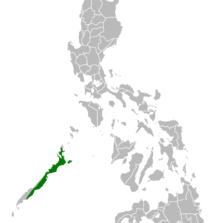Siebenrockiella leytensis
| Philippine forest turtle | |
|---|---|
 |
|
| Scientific classification | |
| Kingdom: | Animalia |
| Phylum: | Chordata |
| Class: | Reptilia |
| Order: | Testudines |
| Suborder: | Cryptodira |
| Family: | Geoemydidae |
| Genus: | Siebenrockiella |
| Species: | S. leytensis |
| Binomial name | |
|
Siebenrockiella leytensis (Taylor, 1920) |
|
 |
|
| Known areas of occurrence of Siebenrockiella leytensis. | |
| Synonyms | |
|
|
Siebenrockiella leytensis is a species of freshwater turtle endemic to the Philippines. It is classified as critically endangered. It is known as the Philippine forest turtle, the Philippine pond turtle, the Palawan turtle, or the Leyte pond turtle. Despite the latter common name, it does not occur in the island of Leyte but is instead native to the Palawan island group.
Philippine forest turtles are readily recognizable by their ginkgo-shaped vertebral scutes and a pale white to yellow line traversing across its head behind the ears. The previous characteristic has earned it the nickname of 'bowtie turtle'.
Philippine forest turtles are classified under the subgenus Panyaenemys. Together with the smiling terrapin (Siebenrockiella crassicollis), it is one of the two species in the genus Siebenrockiella.
Philippine forest turtles have brown to reddish brown to black carapaces that reach a length of 21 cm (8.3 in). Larger individuals can reach 30 cm (12 in) in length, though this is relatively rare. A dorsal ridge (the keel) is only present in the posterior vertebral scutes or absent altogether. The front margin of the carapace is slightly to strongly serrated, with the marginal scutes projecting beyond the cervical scutes. The vertebral scutes are broader than long.
The plastron is reddish brown to black, sometimes with blotches of yellow. In juveniles, the plastron is a uniform yellow. The bridge (the hinge connecting plastron and carapace) is the same color as the plastron. It is significantly smaller than the carapace and narrow at the front and back. It possesses deep notches between the projecting gular scutes as well as between the gulars and humerals, but it is more distinct in the former.
Its plastral formula is abd > pect > fem > gul > hum > an.
...
Wikipedia

